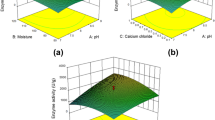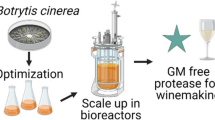Abstract
Cationic polypeptide proteins found in the seeds of the tropical plant Moringa oleifera have coagulation efficiencies similar to aluminum and ferric sulfates without their recalcitrant nature. Although these proteins possess great potential to augment or replace traditional coagulants in water treatment, harvesting active protein from seeds is laborious and not cost-effective. Here, we describe an alternative method to express and secrete active M. oleifera coagulant protein (MO) in Bacillus subtilis. A plasmid library containing the MO gene and 173 different types of secretory signal peptides was created and cloned into B. subtilis strain RIK1285. Fourteen of 440 clones screened were capable of secreting MO with yields ranging from 55 to 122 mg/L of growth medium. The coagulant activity of the highest MO secreting clone was evaluated when grown on Luria broth, and cell-free medium from the culture was shown to reduce turbidity in a buffered kaolin suspension by approximately 90% compared with controls without the MO gene. The clone was also capable of secreting active MO when grown on a defined synthetic wastewater supplemented with 0.5% tryptone. Cell-free medium from the strain harboring the MO gene demonstrated more than a 2-fold reduction in turbidity compared with controls. Additionally, no significant amount of MO was observed without the addition of the synthetic wastewater, suggesting that it served as a source of nutrients for the effective expression and translocation of MO into the medium.







Similar content being viewed by others
References
Abdulazeez QM, Jami MS, Alam MZ (2016) Effective sludge dewatering using Moringa oleifera seed extract combined with aluminium sulfate. J Eng Appl Sci 11:372–381
Ali EN, Muyibi SA, Salleh HM, Alam MZ, Salleh MRM (2010) Production of natural coagulant from Moringa oleifera for application in treatment of low turbidity water. J Wat Resour Prot 2:259–266
Bradford MM (1976) A rapid and sensitive method for the quantitation of microgram quantities of protein utilizing the principle of protein-dye binding. Anal Biochem 72:248–254
Brockmeier U, Caspers M, Freudl R, Jockwer A, Noll T, Eggert T (2006) Systematic screening of all signal peptides from Bacillus subtilis: a powerful strategy in optimizing heterologous protein secretion in Gram-positive bacteria. J Mol Biol 362:393–402
Broin M, Santaella C, Cuine S, Kokou K, Peltier G, Joët T (2002) Flocculent activity of a recombinant protein from Moringa oleifera Lam. seeds. Appl Microbiol Biotechnol 60:114–119
Brown S, Maria JPS, Walker S (2013) Wall teichoic acids of Gram-positive bacteria. Annu Rev Microbiol 67:313–336
Cazcarro I, López-Morales C, Duchin F (2016) The global economic costs of the need to treat polluted water. Econ Syst Res 28:295–314
Chen X, Zaro J, Shen W-C (2013) Fusion protein linkers: property, design and functionality. Adv Drug Deliv Rev 65:1357–1369
De Souza FL, De Castro Silva Pedrangelo A, De Matos Silva PK, REC DA, Yamaguchi NU, Ribeiro RM (2017) Water treatment with conventional and alternative coagulants. Chem Eng Trans 57:1189–1194
Edzwald K (1993) Coagulation in drinking water treatment: particles, organics and coagulants. Wat Sci Technol 27:21–35
EPA (1993) Standards for the use and disposal of sewage sludge. 40 CFR 503
Flaten TP (2001) Aluminium as a risk factor in Alzheimer’s disease, with emphasis on drinking water. Brain Res Bull 55:187–196
Fu LL, Xu ZR, Li WF, Shuai JB, Lu P, Hu CX (2007) Protein secretion pathways in Bacillus subtilis: implications for optimization of heterologous protein secretion. Biotechnol Adv 25:1–12
Gasteiger E, Hoogland C, Gattiker A, Duvaud S, Wilkins MR, Appel RD, Bairoch A (2005) Protein identification and analysis tools on the ExPASy server. In: Walker JM (ed) The proteomics protocols handbook. Humana Press, pp 571–607
Ghebremichael KA, Gunaratna KR, Henriksson H, Brumer H, Dalhammar G (2005) A simple purification and activity assay of the coagulant protein from Moringa oleifera seed. Wat Res 39:2338–2344
Hemmerich J, Rohe P, Kleine B, Jurischka S, Wiechert W, Freudl R, Oldiges M (2016) Use of a Sec signal peptide library from Bacillus subtilis for the optimization of cutinase secretion in Corynebacterium glutamicum. Microb Cell Fact 15:208–219
Kansal SK, Kumari A (2014) Potential of M. oleifera for the treatment of water and wastewater. Chem Rev 114:4993–5010
Kluczka J, Zołotajkin M, Ciba J, Staroń M (2017) Assessment of aluminum bioavailability in alum sludge for agriculture utilization. Environ Monit Assess 189:422
León-Luque AJ, Cl B, Peña-Guzmán CA (2016) Determination of the optimal dosage of aluminum sulfate in the coagulation-flocculation process using an artificial neural network. Int J Environ Sci Dev 7:346–350
Li W, Zhou X, Lu P (2004) Bottlenecks in the expression and secretion of heterologous proteins in Bacillus subtilis. Res Microbiol 155:605–610
Murayama R, Akanuma G, Mankino Y, Nanamiya H, Kawamura F (2004) Spontaneous transformation and use for genetic mapping in Bacillus subtilis. Biosci Biotechnol Biochem 68:1672–1680
Muyibi SA, Evison LM (1995) Optimizing physical parameters affecting coagulation of turbid water with Moringa oleifera seeds. Wat Res 29:289–2695
Narasiah KS, Vogel A, Kramadhati N (2002) Coagulation of turbid waters using Moringa oleifera seeds from two distinct sources. Wat Sci Technol 2:83–88
Ndabigengesere A, Subba K, Talbot BG (1995) Active agents and mechanism of coagulation of turbid waters using Moringa oleifera. Wat Res 29:703–710
Nijland R, Kuipers OP (2008) Optimization of protein secretion by Bacillus subtilis. Recent Pat Biotechnol 2:79–87
Nopens I, Capalozza C, Vanrolleghem PA (2001) Stability analysis of a synthetic municipal wastewater. Technical report, Department of Applied Mathematics, Biometrics and Process Control. Tech Universiteit Gent
Okuda T, Baes AU, Nishijima W, Okadam M (2001) Isolation and characterization of coagulant extracted from Moringa oleifera seed by salt solution. Wat Res 35:405–410
Olsona M (2017) Moringa frequently asked questions. Acta Horticulturae 1158:19–32
Pavankumar AR, Noren J, Singh L, Gowda NKC (2014) Scaling-up the production of recombinant Moringa oleifera coagulant protein for large-scale water treatment applications. RCS Adv 4:7136–7141
Petersen TN, Brunak S, von Heijne G, Nielsen H (2011) SignalP 4.0: discriminating signal peptides from transmembrane regions. Nat Methods 8:785–786
Pohl S, Harwood CR (2010) Heterologous protein secretion by Bacillus species: from the cradle to the grave. Adv Appl Microbiol 73:1–25
Poumaye N, Mabingui J, Lutgen P, Bigan M (2012) Contribution to the clarification of surface water from the Moringa oleifera: case M’Poko River to Bangui, Central African Republic. Chem Eng Res Des 90:2346–2352
Rajasulochana P, Preethy V (2016) Comparison on efficiency of various techniques in treatment of waste and sewage water - a comprehensive review. Resour Eff Technol 2:175–184
Ramachandran C, Peter KV, Gopalakrishnan PK (1980) Drumstick (Moringa oleifera): a multipurpose Indian vegetable. Economic Botany 34:276–283
Ramavandi B (2014) Treatment of water turbidity and bacteria by using a coagulant extracted from Plantago ovata. Water Resour Ind 6:36–50
Ramos KRM, Valdehuesa KNG, Cabulong RB, Moron LS, Nisola GM, Hong S-K, Lee W-K, Chung W-J (2016) Overexpression and secretion of AgaA7 from Pseudomonas hodoensis sp. nov in Bacillus subtilis for depolymerization of agarose. Enzyme Microb Technol 90:19–25
Ravani A, Prasad RV, Gajeral RR, Joshi DC (2017) Potentiality of Moringa oleifera for food and nutritional security. Ag Rev 38:228–232
Schallmey M, Singh A, Ward OP (2004) Developments in the use of Bacillus species for industrial production. Can J Microbiol 50:1–17
Schumann W (2007) Production of recombinant proteins in Bacillus subtilis. Adv Appl Microbiol 62:137–189
Seiple T, Coleman AM, Skaggs RL (2017) Municipal wastewater sludge as a sustainable bioresource in the United States. J Environ Manage 197:673–680
Suarez M, Entenza JM, Doerries C, Meyer E, Bourquin L, Sutherland J, Marison I, Moreillon P, Mermod N (2002) Expression of a plant-derived peptide harboring water-cleaning and antimicrobial activities. Biotech Bioeng 81:13–20
Sulistyo H, Rahayu SS, Sediawan WB, Sarto Y, Nainggolan R (2012) Water treatment by coagulation-flocculation using ferric sulphate as coagulant. ASEAN J Chem Eng 12:42–50
Tjalsma H, Bolhuis A, Jongbloed JDH, Bron S, Van Dijl JM (2000) Signal peptide-dependent protein transport in Bacillus subtilis: a genome-based survey of the secretome. Microbiol Mol Biol Rev 64:515–547
Tsuji S, Tanaka K, Takenaka S, Yoshida K (2015) Enhanced secretion of natto phytase by Bacillus subtilis. Biosci Biotechnol Biochem 11:1906–1904
United Nations World Water Assessment Programme (2017) The United Nations World Water Development Report 2017 - wastewater: the untapped resource. UNESCO, Paris
van Dijl JM, Hecker M (2013) Bacillus subtilis: from soil bacterium to super-secreting cell factory. Microb Cell Fact 12:3
Yongabi KA (2010) Biocoagulants for water and waste water purification a review. Int Rev Chem Eng 2:444–458
Yoong P, Schuch R, Nelson D, Fischetti VA (2006) PlyPH, a bacteriolytic enzyme with a broad pH range of activity and lytic action against Bacillus anthracis. J Bacteriol 188:2711–2714
Young D (2012) A comparison of aluminum and iron-based coagulants for the treatment of surface water in Sarasota County, Florida. University of Central Florida, Thesis
Acknowledgments
This research was supported in part by an appointment at the Research Participation Program administered by the Oak Ridge Institute for Science and Education through a cooperative agreement between the US Department of Energy and the US Army Construction Engineering Research Laboratory. Although this research was sponsored by the Department of Defense, the content of the information does not necessary reflect the position or policy of the government and no official endorsement should be inferred.
Author information
Authors and Affiliations
Corresponding author
Ethics declarations
The authors of this article did not perform any studies with animals or human subjects.
Conflict of interest
The authors declare that they have no conflicts of interest.
Additional information
Publisher’s note
Springer Nature remains neutral with regard to jurisdictional claims in published maps and institutional affiliations.
Rights and permissions
About this article
Cite this article
Arnett, C., Lange, J., Boyd, A. et al. Expression and secretion of active Moringa oleifera coagulant protein in Bacillus subtilis. Appl Microbiol Biotechnol 103, 9411–9422 (2019). https://doi.org/10.1007/s00253-019-10141-5
Received:
Revised:
Accepted:
Published:
Issue Date:
DOI: https://doi.org/10.1007/s00253-019-10141-5




